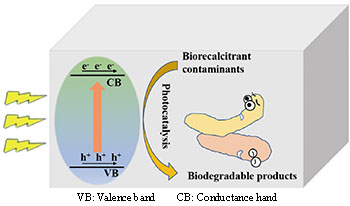• 综述 •
丁蕊, 赵峰. 光催化耦合微生物同步降解污染物[J]. 化学进展, 2017, 29(9): 1154-1158.
Rui Ding, Feng Zhao. Intimate Coupling of Photocatalysis and Biodegradation to Synchronously Degrade Pollutants[J]. Progress in Chemistry, 2017, 29(9): 1154-1158.

中图分类号:
分享此文:
| [1] Zheng Y, Xiao Y, Yang Z H, Wu S, Xu H J, Liang F Y, Zhao F. Process Biochem., 2014, 49(8):1345. [2] Liang F Y, Xiao Y, Zhao F. Chem. Eng. J., 2013, 218:147. [3] Onesios K M, Jim T Yu, Bouwer E J. Biodegradation, 2009, 20(4):441. [4] 李娟(Li J). 西安建筑科技大学硕士论文(Master Dissertation of Xi'an University of Architecture and Technology), 2008. [5] Wang S H, Zheng Y, Yan W F, Chen L X, Mahadevan G D, Zhao F. J. Hazard. Mater., 2016, 320:393. [6] Wang L, Liu Y L, Ma J, Zhao F. Water Res., 2016, 88:322. [7] Yan N, Xia S Q, Xu L K, Zhu J, Zhang Y M, Rittmann B E. Appl. Microbiol. Biot., 2012, 94(2):527. [8] Zhang Y M, Wang L, Rittmann B E. Appl. Microbiol. Biot., 2010, 86(6):1977. [9] Yang L H, Zhang Y M, Bai Q, Yan N, Xu H, Rittmann B E. J. Hazard. Mater., 2015, 287:252. [10] Zhang G G, Zhang J S, Zhang M W, Wang X C. J. Mater. Chem., 2012, 22(16):8083. [11] Rincón A G, Pulgarin C. Appl. Catal. B-Environ., 2004, 49(2):99. [12] Chong M N, Jin B, Chow C W K, Saint C. Water Res., 2010, 44(10):2997. [13] Chang L, Zhang Y M, Gan L, Xu H, Yan N, Liu R, Rittmann B E. Biodegradation, 2014, 25(4):587. [14] 阎宁(Yan N), 夏四清(Xia S Q), 朱骏(Zhu J), 张永明(Zhang Y M). 环境科学(Environmental Science), 2011, 10:045. [15] Wang W B, Kirumba G, Zhang Y M, Wu Y Q, Rittmann B E. Biodegradation, 2015, 1:1. [16] Rittmann B E. 上海师范大学学报(自然科学版) (Journal of Shanghai Normal University(Natural Sciences)), 2014, 43(1):1. [17] Marsolek M D, Torres C I, Hausner M, Rittmann B E. Biotechnol. Bioeng., 2008, 101(1):83. [18] Zhang Y M, Pu X J, Fang M M, Zhu J, Chen L J, Rittmann B E. Biodegradation, 2012, 23(4):575. [19] Li G Z, Park S, Rittmann B E. Water Res., 2012, 46(19):6489. [20] Buchtmann C, Kies U, Deckwer W D, Hecht V. Biotechnol. Bioeng., 1997, 56(3):295. [21] Wen D H, Li G Z, Xing R, Park S, Rittmann B E. Appl. Microbiol. Biot., 2012, 95(1):263. [22] Li G Z, Park S, Kang D W, Brown R K, Rittmann B E. Environ. Sci. Technol., 2011, 45(19):8359. [23] Wang Z J, Zheng Z Y, Zheng S Q, Chen S L, Zhao F. Journal of Power Sources, 2015, 287:269. [24] Schneider J, Matsuoka M, Takeuchi M, Zhang J L, Horiuchi Y, Anpo M, Bahnemann D W. Chem. Rev., 2014, 114(19):9919. [25] Pelaez M, Nolan N T, Pillai S C, Seery M K, Falaras P, Kontos A G, Dunlop P S, Hamilton J W, Byrne J A, O'shea K. Appl. Catal. B-Environ., 2012, 125:331. [26] Zhang L L, Xing Z P, Zhang H, Li Z Z, Wu X Y, Zhang X D, Zhang Y, Zhou W. Appl. Catal. B-Environ., 2016, 180:521. [27] Lim T H, Kim S D. Chemosphere, 2004, 54(3):305. [28] Zhou D D, Xu Z X, Dong S S, Huo M X, Dong S S, Tian X D, Cui B, Xiong H F, Li T T, Ma D M. Environ. Sci. Technol., 2015, 49(13):7776. [29] Yu K, Zhang T. PloS one, 2012, 7(5):e38183. [30] Adav S S, Chen M Y, Lee D J, Ren N Q. Biotechnol. Bioeng., 2007, 96(5):844. [31] Itoh K, Tashiro Y, Uobe K, Kamagata Y, Suyama K, Yamamoto H. Appl. Environ. Microb., 2004, 70(4):2110. [32] Steinle P, Stucki G, Stettler R, Hanselmann K W. Appl. Environ. Microb., 1998, 64(7):2566. [33] Zhou D D, Dong S S, Shi J L, Cui X C, Ki D W, Torres, Rittmann B E. Chem. Eng. J., 2017, 317:882. [34] Li G Z, Park S, Rittmann B E. Biotechnol. Bioeng., 2012, 109(4):884. [35] Sarmah A K, Meyer M T, Boxall A B. Chemosphere, 2006, 65(5):725. [36] Xiong H F, Zou D L, Zhou D D, Dong S S, Wang J W, Rittmann B E. Chem. Eng. J., 2017, 316:7. |
| [1] | 王丹丹, 蔺兆鑫, 谷慧杰, 李云辉, 李洪吉, 邵晶. 钼酸铋在光催化技术中的改性与应用[J]. 化学进展, 2023, 35(4): 606-619. |
| [2] | 刘雨菲, 张蜜, 路猛, 兰亚乾. 共价有机框架材料在光催化CO2还原中的应用[J]. 化学进展, 2023, 35(3): 349-359. |
| [3] | 兰明岩, 张秀武, 楚弘宇, 王崇臣. MIL-101(Fe)及其复合物催化去除污染物:合成、性能及机理[J]. 化学进展, 2023, 35(3): 458-474. |
| [4] | 李锋, 何清运, 李方, 唐小龙, 余长林. 光催化产过氧化氢材料[J]. 化学进展, 2023, 35(2): 330-349. |
| [5] | 杨世迎, 李乾凤, 吴随, 张维银. 铁基材料改性零价铝的作用机制及应用[J]. 化学进展, 2022, 34(9): 2081-2093. |
| [6] | 宝利军, 危俊吾, 钱杨杨, 王雨佳, 宋文杰, 毕韵梅. 酶响应性线形-树枝状嵌段共聚物的合成、性能及应用[J]. 化学进展, 2022, 34(8): 1723-1733. |
| [7] | 范倩倩, 温璐, 马建中. 无铅卤系钙钛矿纳米晶:新一代光催化材料[J]. 化学进展, 2022, 34(8): 1809-1814. |
| [8] | 马晓清. 石墨炔在光催化及光电催化中的应用[J]. 化学进展, 2022, 34(5): 1042-1060. |
| [9] | 李晓微, 张雷, 邢其鑫, 昝金宇, 周晋, 禚淑萍. 磁性NiFe2O4基复合材料的构筑及光催化应用[J]. 化学进展, 2022, 34(4): 950-962. |
| [10] | 刘洋洋, 赵子刚, 孙浩, 孟祥辉, 邵光杰, 王振波. 后处理技术提升燃料电池催化剂稳定性[J]. 化学进展, 2022, 34(4): 973-982. |
| [11] | 陈晓峰, 王开元, 梁芳铭, 姜睿祺, 孙进. 外泌体递药系统及其在肿瘤治疗中的应用[J]. 化学进展, 2022, 34(4): 773-786. |
| [12] | 庞欣, 薛世翔, 周彤, 袁蝴蝶, 刘冲, 雷琬莹. 二维黑磷基纳米材料在光催化中的应用[J]. 化学进展, 2022, 34(3): 630-642. |
| [13] | 孙义民, 李厚燊, 陈振宇, 王东, 王展鹏, 肖菲. MXene在电化学传感器中的应用[J]. 化学进展, 2022, 34(2): 259-271. |
| [14] | 王楠, 周宇齐, 姜子叶, 吕田钰, 林进, 宋洲, 朱丽华. 还原-氧化协同降解全/多卤代有机污染物[J]. 化学进展, 2022, 34(12): 2667-2685. |
| [15] | 漆晨阳, 涂晶. 无抗生素纳米抗菌剂:现状、挑战与展望[J]. 化学进展, 2022, 34(11): 2540-2560. |
| 阅读次数 | ||||||
|
全文 |
|
|||||
|
摘要 |
|
|||||